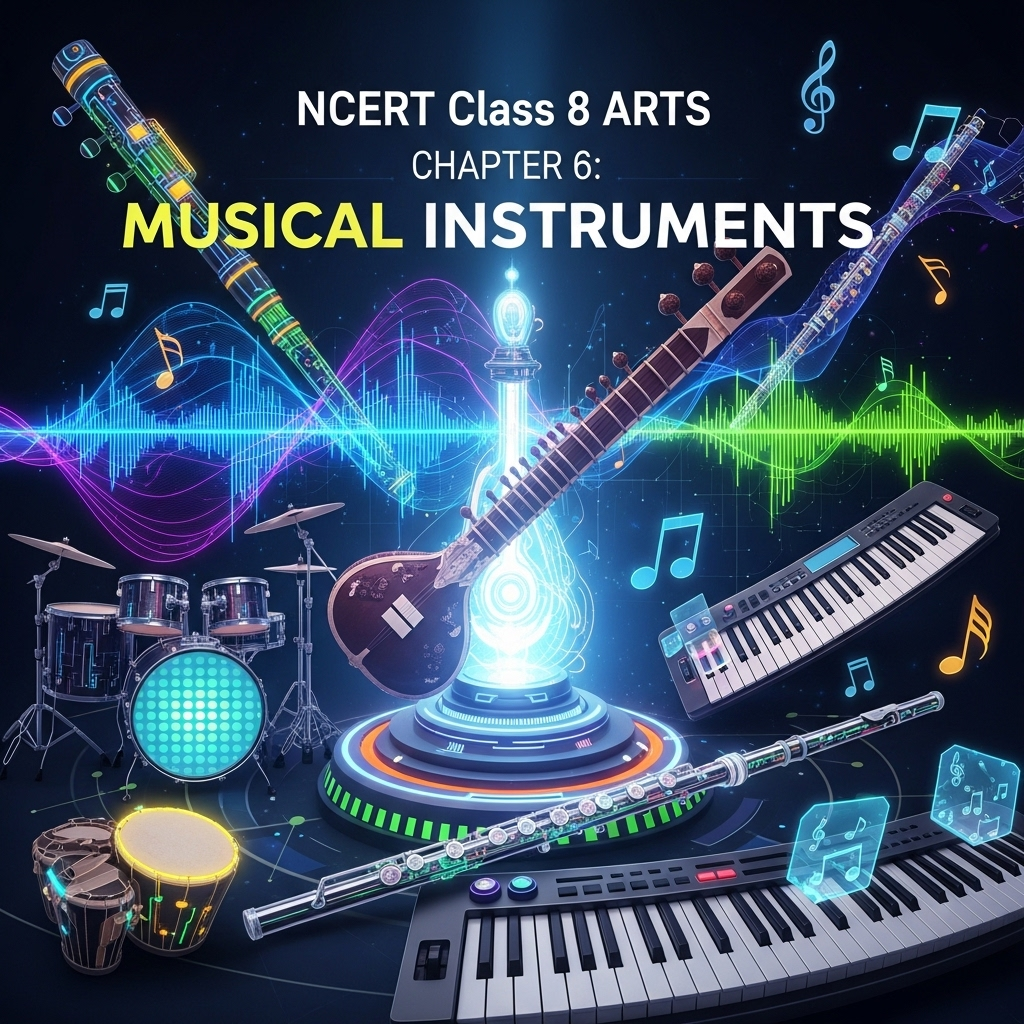Complete Solutions and Summary of Musical Instruments – NCERT Class 8, Arts, Chapter 6 – Summary, Questions, Answers, Extra Questions
Detailed summary and explanation of Chapter 6 ‘Musical Instruments’ with all question answers, extra questions, and solutions from NCERT Class VIII, Arts (Kriti).
Updated: 2 months ago

Musical Instruments
Chapter 6: Musical Instruments
Complete Study Guide with Interactive Learning
Chapter Overview
What You'll Learn
Science of Sound
Understanding vibration, resonance, frequency, and timbre in music production.
Making Instruments
Process of crafting musical instruments using scientific principles.
Musicians and Instruments
Life and contributions of legendary musicians like Annapurna Devi, Pannalal Ghosh, and Mysore Doraiswamy Iyengar.
Activities and Assessment
Engaging activities like word search, mapping, crossword, and learning outcomes assessment.
Historical Context
This chapter explores the science behind sound in musical instruments, including concepts like vibration (sound produced by vibrations traveling through mediums) and resonance (amplifying sound in hollow bodies). It discusses timbre as the tone or color of sound varying by material and technique, and poses if music is both art and science.
Key Highlights
The chapter highlights instrument making as essential for traditional art forms, profiles musicians synonymous with their instruments (e.g., Annapurna Devi with Surbahar), and includes activities to find instrument names, map regional percussion, and solve crosswords.
Comprehensive Chapter Summary
1. The Science of Sound
The chapter introduces the science behind sound: Vibration creates sound waves that travel through mediums like air to reach ears. Resonance amplifies sound in hollow bodies, frequency determines pitch (higher vibrations mean higher pitch), and timbre refers to the tone or color varying by material, construction, and playing technique. It questions if music is both art and science.
2. Making Musical Instruments
Importance of Makers
Makers are essential for traditional art survival, using scientific principles. Example: Crafting a drum from wood log to cylindrical shape, fixing head, and tuning with straps.
Teacher Note
Invite an instrument maker for demonstration to show their societal importance.
Process Overview
Starts with shaping wood, creating drum head, fixing it, and tuning with straps.
3. Musicians and Their Instruments
Annapurna Devi - Surbahar
Born 1927, daughter of Baba Allauddin Khan, mastered surbahar (bass sitar) despite it being demanding for women. Taught acclaimed musicians like Hariprasad Chaurasia.
Pannalal Ghosh - Flute
Born 1911, popularized bansuri in Hindustani music, experimented with longer bamboo flute for better pitch, composed for films.
Mysore Doraiswamy Iyengar - Veena
Born 1920, developed Mysore Bani style, court musician, received awards like Padma Bhushan (1983).
4. Activities
Activity 6.1: Word Search
Find instrument names like Bansuri, Flute, Guitar, Sitar in a grid.
Activity 6.2: Map Instruments
Mark regional percussion like Udukkai (Tamil Nadu), Chenda (Kerala) on India map.
Activity 6.3: Crossword
Solve clues for instruments like Santoor, Pakhawaj, Tabla, Sitar.
5. Assessment
Learning outcomes: Awareness of instruments and origins, understanding sound principles, awareness of legendary musicians' lives and contributions.
Key Concepts and Definitions
Vibration
Sound produced by vibrations creating waves through mediums like air.
Resonance
Amplification of sound in hollow bodies or cavities.
Frequency
Number of vibrations per second; higher frequency means higher pitch.
Timbre
Tone or color of sound, varying by material, construction, and technique.
Surbahar
Bass sitar with deeper tones, used for elaborate alaap.
Bansuri
Indian flute, popularized by Pannalal Ghosh with 32-inch bamboo version.
Important Facts and Figures
Questions and Answers from Chapter
Short Questions
Q1. What is timbre?
Q2. What produces sound?
Q3. What is resonance?
Q4. What is frequency?
Q5. What instrument did Annapurna Devi play?
Q6. When was Pannalal Ghosh born?
Q7. What is surbahar also called?
Q8. What material is used for drum head?
Q9. What style did Iyengar develop?
Q10. What award did Iyengar receive in 1983?
Q11. What is Udukkai from?
Q12. What is a percussion instrument from Kerala?
Q13. What is the crossword clue for 1 across?
Q14. What is the learning outcome 3.1?
Q15. What flute length did Ghosh settle on?
Medium Questions
Q1. Explain how timbre varies.
Q2. Describe resonance with an example.
Q3. How does frequency affect pitch?
Q4. What is the role of instrument makers?
Q5. Who was Annapurna Devi's father?
Q6. What did Pannalal Ghosh experiment with?
Q7. What awards did Iyengar receive?
Q8. List three words from Activity 6.1.
Q9. Name three regional instruments from Activity 6.2.
Q10. What is clue 3 across in crossword?
Q11. What is clue 4 across?
Q12. What is clue 11 down?
Q13. What is learning outcome 4.1?
Q14. Describe surbahar.
Q15. What film did Ghosh debut in?
Long Questions
Q1. Discuss the science of sound in musical instruments.
Q2. Explain the process of making a musical instrument like a drum.
Q3. Describe Annapurna Devi's life and contributions.
Q4. Discuss Pannalal Ghosh's contributions to flute.
Q5. Explain Mysore Doraiswamy Iyengar's achievements.
Q6. Describe Activity 6.1 and its note.
Q7. Explain Activity 6.2 with examples.
Q8. Solve and explain the crossword clues.
Q9. Discuss the assessment learning outcomes.
Q10. How is music both art and science?
Q11. Describe the three maestros in the photo.
Q12. Explain Iyengar's early life.
Q13. What did Ghosh do in films?
Q14. Describe surbahar's features.
Q15. How did Ghosh popularize flute?
Interactive Knowledge Quiz
Test your understanding of Musical Instruments
Quick Revision Notes
Science of Sound
- Vibration creates waves
- Resonance amplifies
- Frequency for pitch
Making Instruments
- Wood to cylinder
- Fix head, tune straps
- Scientific principles
Musicians
- Devi: Surbahar
- Ghosh: Flute
- Iyengar: Veena
Activities
- Word search
- Map percussion
- Crossword
Exam Strategy Tips
- Focus on sound principles
- Memorize musicians' bios
- Practice activities
- Understand outcomes
- Discuss art/science

Group Discussions
No forum posts available.
Easily Share with Your Tribe


